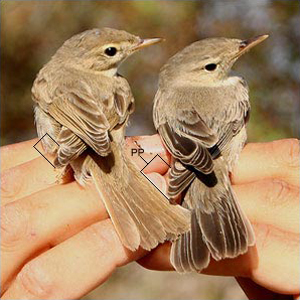Pratique | Identification
Identification d’une Hypolaïs rama capturée en Israël

Hypolaïs rama (Hippolais rama) à gauche et pâle (Iduna pallida elaeica) à droite dans la station de l’IBRCE à Eilat (IsraPel) en septembre 2008 : la projection primaire de l’Hypolaïs pâle est plus longue.
Photographie : Noam Weiss (IBRCE)
Introduction
Les hypolaïs (genres Hippolais et Iduna) posent souvent de sérieux problèmes d’identification aux observateurs débutants ou même confirmés. C’est particulièrement le cas de deux espèces proches, au plumage gris-brun : les Hypolaïs pâle (Iduna pallida) et bottée (I. caligata). Pour compliquer les choses, la sous-espèce orientale I. c. rama (région transcaspienne et Asie centrale) de l’Hypolaïs bottée a récemment été élevé eau rang d’espèce distincte, qui a été appelée Hypolaïs rama.
Un oiseau a été capturé en 2008 à l’IBRCE (International Birding & Research Centre in Eilat, Israël), et nous vous proposons une version française de la description de l’oiseau : ce sera pour nous l’occasion de présenter un oiseau encore très peu connu des ornithologues ouest-européens, et d’évoquer les critères permettant de le distinguer de la sous-espèce elaeica de l’Hypolaïs pâle.
Abstract
Sykes’ Warbler, Iduna rama, is an Old World warbler in the tree warbler genus Iduna. It was formerly considered conspecific with Booted Warbler, but is now usually considered a separate species. Its breeding range is from the Caspian Sea area to Central Asia. It migrates winter in the Indian subcontinent as far south as Sri Lanka.
On the morning of the 21/9/08, Noam Weiss from IBRCE (Eilat) noticed a little brown bird in one of their mist nets. Arriving at the bird it looks confusing with a Phylloscopus jizz but the color of an Acrocephalus. Out of the net it became clear that this is a Iduna Warbler, but nothing like an Olivaceous Warbler. It looked very much like the Booted Warbler (Iduna caligata), but the head and bill were longer, the tail looked somewhat longer too and the shape was not as strikingly Phylloscopus like. After years of examining short winged Olivaceous Warblers that they occasionally catch at the IBRCE Ringing Station it was clear that this bird was actually a Syke’s Warbler.
Poursuivez la lecture de cet article, en vous abonnant dès maintenant !
Découvrez les Archives d’Ornithomedia.com
Pour seulement 10,00 €TTC/an (ou 6,00 € les 6 mois)
Profitez de plusieurs centaines d’articles en accès illimité et sans aucun engagement.
Compléments
À lire sur Ornithomedia.com
- Identifier et observer l’Hypolaïs obscure en Espagne
- Identifier la Rousserolle des buissons en main : un cas aux Pays-Bas
À lire sur le web
- Vous pouvez découvrir d’autres photos d’oiseaux bagués à l’IBRCE sur le site web du centre : www.birdsofeilat.com
- La galerie de photos de Thomas Luiten: www.pbase.com/thomasluiten
Ouvrages recommandés
- Reed and Bush Warblers de David Pearson, Peter Kennerley et Brian Small (2010)
- Warbler Songs and Calls of Britain and Europe de Geoff Sample
- Sylvia Warblers de Hadoram Shirihai, Gabriel Gargallo, Andreas J. Helbig
- Identification Guide to European Passerines de Lars Svensson (1992)
- Le guide ornitho de L. Svensson et al
- La voix des oiseaux : Une nouvelle approche des cris et des chants (2CD audio) de Mark Constantine, The Sound Approach et Guilhem Lesaffre




Aucun commentaire sur ce sujet
Participer à la discussion !